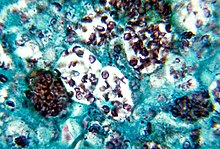**Histoplasmosis Overview:**
– Histoplasmosis is caused by the fungus Histoplasma capsulatum.
– It is found in soil contaminated with bird or bat droppings.
– Common in regions with bird and bat populations.
– Occupational risk for workers in construction, agriculture, and spelunking.
– Outbreaks reported among tunnel workers and individuals exposed to contaminated environments.
**Clinical Aspects of Histoplasmosis:**
– Symptoms vary from asymptomatic to severe respiratory illness.
– Can affect lungs, skin, eyes, and other organs.
– Chronic pulmonary histoplasmosis can mimic tuberculosis.
– Disseminated histoplasmosis is severe and can be fatal if untreated.
– Diagnosis involves culture, histopathology, and antigen testing.
**Treatment and Management:**
– Antifungal medications like itraconazole and amphotericin B are used.
– Severe cases may require hospitalization and intravenous antifungal therapy.
– Immunocompromised individuals may need lifelong antifungal treatment.
– Monitoring for relapse is crucial during and after treatment.
– Early diagnosis and treatment improve outcomes.
**Complications of Histoplasmosis:**
– Chronic pulmonary histoplasmosis can lead to lung scarring.
– Disseminated histoplasmosis can affect multiple organs.
– Ocular histoplasmosis can cause vision loss if untreated.
– Immunocompromised individuals are at higher risk of severe complications.
– Complications can be life-threatening if not managed promptly.
**Prevention and Control Strategies:**
– Avoiding activities that expose individuals to contaminated soil.
– Using personal protective equipment in high-risk occupations.
– Educating individuals about the risks of histoplasmosis.
– Implementing environmental controls in workplaces with exposure risk.
– Early detection and management of outbreaks are essential for preventing transmission.
Histoplasmosis is a fungal infection caused by Histoplasma capsulatum. Symptoms of this infection vary greatly, but the disease affects primarily the lungs. Occasionally, other organs are affected; called disseminated histoplasmosis, it can be fatal if left untreated.
| Histoplasmosis | |
|---|---|
| Other names | Cave disease, Darling's disease, Ohio valley disease, Reticuloendotheliosis, Spelunker's lung and Caver's disease |
 | |
| Histoplasma capsulatum. Methenamine silver stain showing histopathologic changes in histoplasmosis | |
| Specialty | Infectious disease |
Histoplasmosis is common among AIDS patients because of their suppressed immunity. In immunocompetent individuals, past infection results in partial protection against ill effects if reinfected.
Histoplasma capsulatum is found in soil, often associated with decaying bat guano or bird droppings. Disruption of soil from excavation or construction can release infectious elements that are inhaled and settle into the lung.
From 1938 to 2013 in the US, 105 outbreaks were reported in a total of 26 states plus Puerto Rico. In 1978 to 1979 during a large urban outbreak in which 100,000 people were exposed to the fungus in Indianapolis, victims had pericarditis, rheumatological syndromes, esophageal and vocal cord ulcers, parotitis, adrenal insufficiency, uveitis, fibrosing mediastinitis, interstitial nephritis, intestinal lymphangiectasia, and epididymitis. Histoplasmosis mimics colds, pneumonia, and the flu, and can be shed by bats in their feces.
